
kapon
spay/neuter
@catsofdecolonialfutures on
why kapon?
where to kapon?
if you're in NCR south, we recommend Paw & Claw Veterinary Clinic on Aguirre Avenue in BF Homes for their expert low-cost kapon service. They also have another clinic in BF Resort.
Other low-cost kapon clinics are located in Mandaluyong, Makati and Quezon City.
We recommend Biyaya Animal Care on Katarungan in Mandaluyong.
we don’t want pregnancies and new litters.
we want to eliminate the chance of testicular, ovarian and breast cancer as pets get older.
we don’t want our pets to catch or spread contagious parasites or diseases.
we want to reduce sexual and territorial behaviour to promote safe socialisation.
kapon should be accessible! low-cost kapon options are important.

healthy enough to undergo surgery, no signs of respiratory issues (complete blood count recommended but not always needed)
six months of age or older
in heat a while ago, or currently in heat
suspected pregnant
Naat recovering from spay-abort, September 2022
She was a free-roaming stray, initially trapped for TNVR (trap-neuter-vaccinate-return), but remained in long-term rehab and fosterhood due to other chronic health issues uncovered during her two-week recovery from surgery.
tnvr
trap - neuter - vaccinate - return
this method is used by stray carers to control overpopulation, limit spread of disease, and vastly improve health and lifespan of entire cat colonies and dog packs.
our process for TNVR'ing cats is provided in full below.
when to kapon?
pre-surgery prep
fast the individuals for at least SIX hours before surgery. this means no access to food or water.
individuals should be transported in secure carriers, one individual per carrier.
for feral individuals, carriers should be extra secure. this is important for the safety of the individual and for everyone involved in their care.
the size of the carrier should be sufficient for them to lie down and breathe freely while still under the infulence of anaesthesia.
fabric or bag carriers are not recommended as they may not be safe or secure enough.
post-kapon recovery
we recommend to cage-rest healthy freshly-neutered male cats for 24h.
we recommend to cage-rest healthy freshly-spayed female cats for 7 days.
we recommend to cage-rest freshly-aborted female cats for 14 days.
sometimes even if a cat is healthy pre-surgery, stress-triggered symptoms can arise in recovery. we recommend to continue cage-resting the individual, until their symptoms clear up. consult a vet and administer all prescribed medication and care until they are deemed healthy.
during cage-rest, they should not physically exert themselves by jumping or running.
they should not pick at their surgical sites. if they do, place a soft collar on them until fully healed.
the first post-surgery meal is a half-portion meal of their normal food. this may be served after the heaviest effects of anaesthesia have worn off. they should be able to stand up straight and breathe and swallow normally. this is normally around 4-5 hours post-surgery, but can be up to 12 hours for some individuals. feeding too soon after surgery can lead to asphyxiation.
following meals may be served as normal. we recommend mixing vitamin and immune-boosting supplements in their meals to improve recovery.
after cage-resting, return them to their colonies or releasing them to free-roam at home. if possible, keep observing for another 2-3 days.
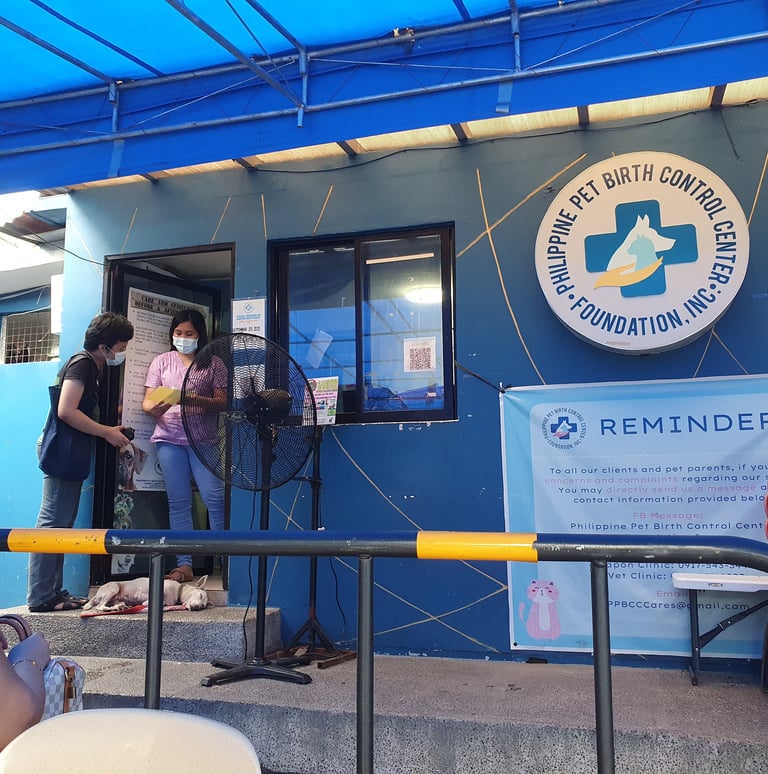

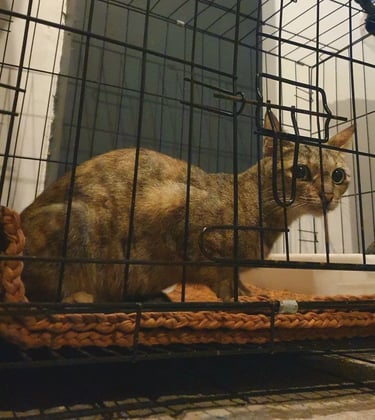

PPBCC in September 2021
Todli fasting for kapon, September 2023


Mum post-kapon, July 2021
use a medium-sized hard travel crate for tnvr, and check that the door mechanisms, all bolts or cable ties are secure.
clean the crate thoroughly with detergent and disinfect it by spraying 3% hydrogen peroxide to saturate all surfaces, leaving to air dry completely.
line the crate with a pee pad.
if trapping a skittish cat you regularly feed, you may need to give them some time to familiarise themselves with this new object. in this case, you might need to place the crate at their feeding location before, during, and after meals for days or even weeks to let them know that the crate is not a threat. you may gradually move their food bowl closer to the crate meal after meal, or try placing it directly in the crate with the door propped open. they may or may not eat from inside the crate, or with you standing nearby. try different set-ups - the goal is to get them comfortable with eating inside the crate.
side note: a larger wire cage is easier for skittish cats to get secure with, since it doesn't feel like too much of a trap.
also, mind biosecurity. wash your hands and feet often. sanitise your shoes frequently.
how we tnvr cats safely
1 familiarise a crate
when the individual is ready, place a bowl of food or treats deep into the crate. ready a clean towel or oven mitt in your hand to safely shut the crate with.
stay calm: they can sense your breath and heartbeat. if you are tense, they will be too.
wait at the door of the crate for the individual to enter, let their guard down and settle to eat comfortably.
this is the moment to calmly close the crate door securely, using not your bare hands but instead the towel or oven mitt.
the cat may go ballistic when it realises it is trapped. cover the crate with the towel, leave the area and allow the individual to calm down.
remember to wash and disinfect your hands and feet thoroughly before and after interacting with stray cats. sun the towel or oven mitt for at least 2h, and then wash thoroughly with detergent, drying completely (ideally in the sun) - before using it again with other cats. using a dryer on high heat will also achieve the same sanitising effect after washing.
2 trap a targeted individual
3 surgery prep
conduct a visual assessment of the trapped individual. what is their health status?
are they severely malnourished? are there any physical injuries? do they have swollen eyes? is there any eye or nose discharge? are they drooling? is there any foul smell from the individual?
if the answer to any of the above is "yes", it may be advisable to consult a vet before scheduling them for kapon. it is possible that they might require a week or two of rehabilitation before they are ready for surgery. this requires space, a recovery cage, litter box, food and water bowls, disinfection supplies, time and money. you are responsible for any health risks as a result of your interventions.
(in cases where some rehab is first required, we would typically deworm the individual on the first day of rehab. if safe to do so, we would administer Broadline while securing them to the side of a cage with a thick towel or blanket. if not, we proceed with WormRid or Prazinate mixed into their food.)
if you are unable to fulfil these responsibilities for any reason, you may choose to simply release the individual and target a different cat for tnvr.
if the individual presents as healthy with no clinical symptoms, they can move on to fasting.
schedule the spay or neuter surgery with your preferred clinic, and remove access to food and water 8h before the scheduled appointment. keep observing closely in case any symptoms arise (this can happen due to stress and may make surgery dangerous for them).
4 travel
cover the crate with a towel or blanket to reduce stress and prevent hysterics as much as possible. you may choose to line the vehicle surface with a tarp or cardboard for biosecurity purposes.
where possible, choose a mode of travel that is quiet, fast, and direct. anti-anxiety sprays or cat nip may help to further reduce stress.
if travelling with multiple animals, place barriers between them and enforce social distancing where possible. this is necessary to prevent spread of parasites and disease (some individuals can still be contagious even if presenting as asymptomatic).
try to disinfect the area of the vehicles in which the crates or cages are placed. if using hydrogen peroxide, spray liberally to saturate surfaces and leave to air-dry. direct sunlight also helps.
if the appointment is at a regular veterinary clinic, call ahead to let them know you are on the way, and to request for the examination table to be disinfected just before your arrival. (our clinics already know to do this whenever we make any appointments, but we always make repeated requests anyway.)
the vet typically conducts either a cursory visual inspection or a full physical assessment. they may have specific questions that you may not have answers to. converse with the vet until you are both satisfied that the individual is not at risk and can proceed safely with spay or neuter surgery.
some vets are poorly trained to deal with stray individuals, and may advise not to proceed if the cat simply shows signs of aggression or heightened stress. they may ask you to return a week later when the individual is more calm. in such cases, our recommendation is to stand your ground. feral and skittish individuals get infinitely more stressed when caged for a week. the vet should consider the experience of the individual as a whole starting from trapping, which is already stressful for them. the vet should not merely concern themself solely from a patient's stress states upon arriving to their clinic.
when we encountered such vet advice in the past, we put our foot down and insisted that our priority is for the overall experience of the individual. holding them for longer unnecessarily and bringing them back to the clinic is only going to cause double the stress. if this clinic will not kapon the individual even if they are healthy, we will take them elsewhere so that they will undergo surgery immediately, so as to reduce the overall stress the individual experiences from the entire tnvr process.
in the case of feral cats especially, we typically request for the vet to conduct a thorough check during surgery, including full dental assessment, to get a better understanding of the health of the individual. in cases where there are obvious issues that also require surgery, we would ask for the vet to include the required procedures within the same sitting.
after surgery, before the individual wakes up, we typically request for ear notches or tattoos, claw trims, ear cleans, and for females, long-acting bacterial shots. in tnvr cases we will insist on 4-in-1 shots as well if we are unsure about the possibility of trapping them again post-kapon.
5 examination & drop-off
6 stay on standby, collection
while waiting for the surgery to be completed, stay on standby with your phone set to loud, as the vet may try to contact you for any emergency decisions should complications arise.
during collection, try to ensure you get adequate time to visually access the cat directly, and to speak with the vet to get the full scope of the health of the individual based on any previously-unknown information gathered during surgery.
do not underestimate the value of recording the conversation or taking notes on your phone. insist upon a prescription or written instructions should the vet make any specific recommendations based on their observations during surgery.
depending on the complications observed, the individual may benefit from overnight boarding for veterinary observation. this is often a safer option for feral individuals, as post-surgery aggression makes them unpredictable and vulnerable. discuss the issues thoroughly with the vet before making a decision that prioritises the safety of everyone involved.
7 settle into recovery
after travelling (again taking the same biosecurity precautions as before), clean, disinfect and set up a single-layer recovery cage, filling it with a towel, blanket or mat, pee pad, litter box with fresh litter, and a light blanket to cover the whole cage. provide the individual with their own litter scoop, and ideally a small cardboard box as a bin that you can easily throw away after. all items should be clean and sanitised.
in caring for feral individuals, use a large recovery cage, placing the litter box and feeding station near the door for easy, safe access.
leave the recovering individual in the travel crate until they are able to stand stably without falling over, usually about 4-5 hours post-surgery.
at this point, transfer the individual to the prepared recovery cage. conduct a visual assessment to check for any emerging symptoms. be mindful that some cats get hyper aggressive post-surgery due to the confusion, pain and anxiety they are experiencing, even if you have always known them to be sweet and gentle.
some cats may be nauseous post-surgery as the anaesthesia wears off. they might keep throwing up clear liquid. this is a common side-effect of anaesthesia. avoid feeding individuals who keep trying to throw up, and wait until they seem to feel a little better, such that they are able to keep a meal down. feeding them when nauseous could lead to asphyxiation.
if they look alert, stable, and responsive, provide half a portion of their standard meal amount. we recommend for at least this first post-surgery meal to contain wet food only. recovery food is best.
if you see signs of aggression emerging, we recommend putting on a soft or hard collar while they are still somewhat dazed, distracted by their hunger.
observe them as they eat to ensure they do not have any problems swallowing their food. should they appear to have difficulty in this, remove the food bowl immediately.
after they have finished their meal, introduce a full water bowl to the recovery cage, cover the cage up with the light blanket, and leave them to rest until the next meal.
for aggressive individuals, do not open the cage door for any reason for least 12 hours, checking on them regularly, by which time the post-surgery aggression should have worn off, and it should be safer to feed them.
8 recovery day two and beyond
feed small regular meals, mixing any prescribed medications, and vitamin and immune-boosting supplements into the meals as you go.
change their water bowl and clean their litter box at least once a day.
with feral individuals, a long stick may come in handy if you find they have pushed their food or water bowls over to the far end of the cage where it might be unsafe to reach in with your fingers. where necessary, use a thick blanket or towel to push the feral cat towards the back of the cage while you quickly clean, remove, or replace items. be wary of escapes.
we recommend to cage-rest healthy freshly-neutered male cats for 24h.
we recommend to cage-rest healthy freshly-spayed female cats for 7 days.
we recommend to cage-rest freshly-aborted female cats for 14 days.
9 vaccinate and return
if you wish to vaccinate the individual before release, males may be vaccinated on day 3 post-surgery, and females may be vaccinated on day 7 post-surgery.
we recommend continuing to cage-rest freshly-vaccinated individuals for at least another 3 days. this is because cats may experience severe side-effects from the vaccines, which requires further care. if the cat remains healthy with no clinical symptoms by day 3 post-vaccine, they are ready to be returned to their colonies.
to return the individual to its colony, bring it in a travel crate to where you found it, or where you know it lives, provide a final full meal, and then release them.
10 clean, wash and disinfect
clean and wash all equipment, including cages, crates, towels, mats, blankets, litter boxes, litter scoops, food and water bowls, etc.
scrub thoroughly with detergent, wash well, and let dry ideally in the sun.
disinfect by spraying all over, especially in hard-to-reach corners, with 3% hydrogen peroxide, saturating all surfaces until dripping wet, and allowing to air-dry, ideally in the sun.
towels, mats and blankets may be laundered and sanitised in a high-heat dryer cycle.
this biosecurity procedure greatly reduces the risk of feline parvovirus spread.
11 take stock
reflect on the entire process from your perspective, and the perspective of the individual.
what was good about the process?
what mistakes were made?
were there any gaps that caused further harm?
what needs to be improved?
was the clinic a good choice?
what questions or discussions need to be raised with the vet in future?
take notes and commit to doing better next time, asking knowledgeable and respected others for advice, acknowledging your own contexts and limitations, clarifying who you might be able to reach out to for help should you need it.
responsible stray care is about constantly learning and evolving, knowing that the stray crisis is always changing.
safety is the top priority.

Taragomi is released after completing TNVR on 24th December 2022. He completed his mange treatment in fosterhood later on and was eventually adopted into his perfect forever home.
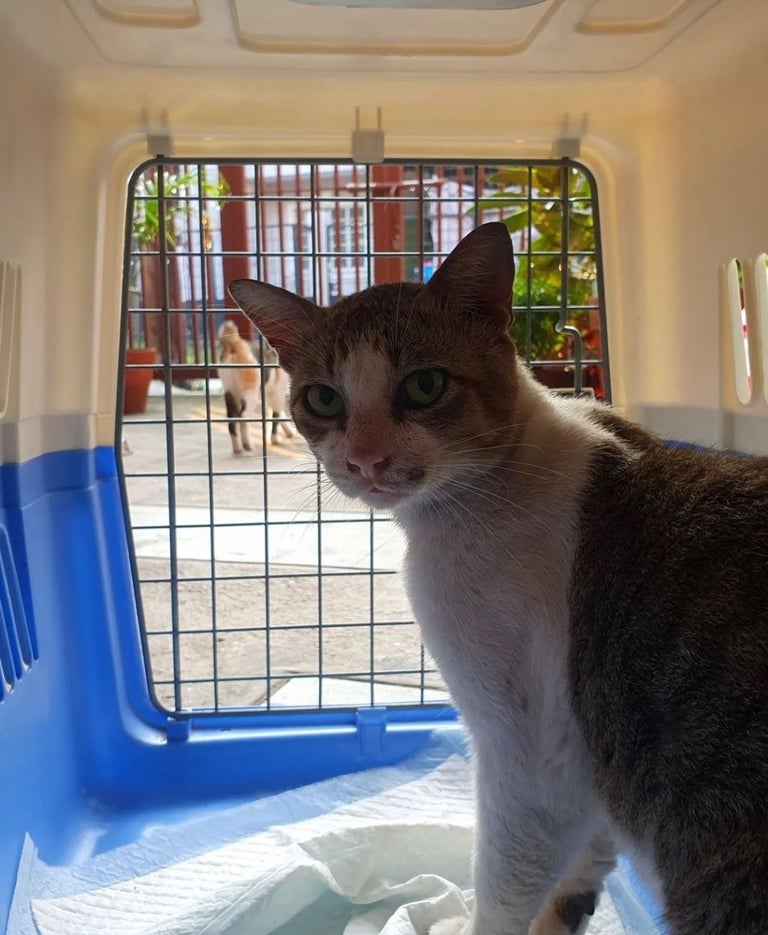

Minokawa secured for TNVR, June 2023

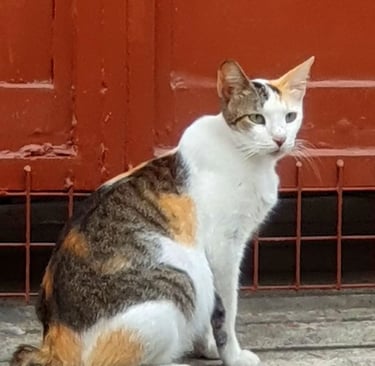
Kirby targeted for late-stage spay-abort,
April 2023
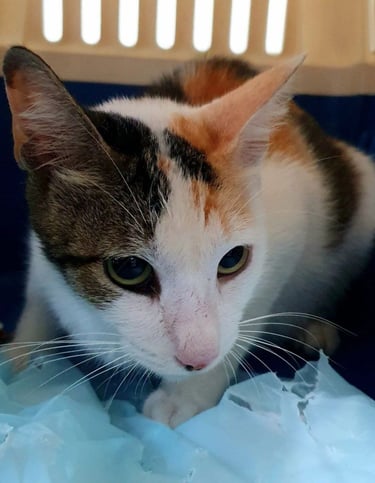

Kirby trapped by one of her feeders, April 2023

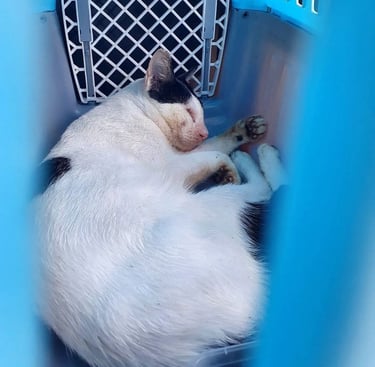
Kilat on his way to neuter surgery, September 2022
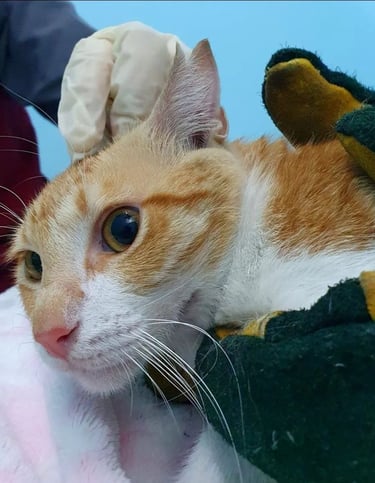

A feral Baitpandi being restrained with thick leather gloves while being examined at the clinic, April 2023
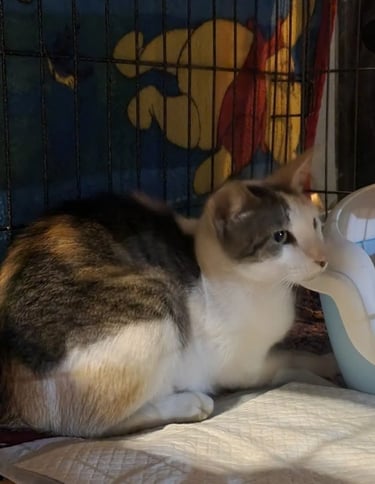

Kirby worriedly settling into recovery after late-stage spay-abort, April 2023

Okami displays severe redirected aggression for 12 hours immediately post-neuter, with aggression peaking around 7h post-kapon, July 2023

Saki was extremely scared and anxious post-kapon, continuously pacing and trying to escape her recovery pen for hours, unable to lie down or rest until this moment when her carer got into the pen with her, July 2023
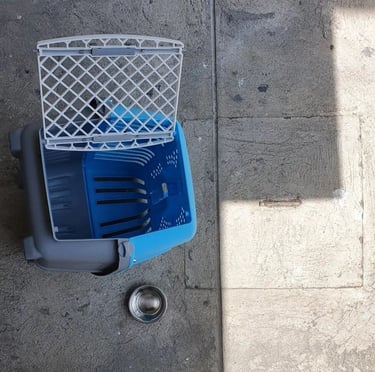

Crate disinfection processes should include at least two rounds of cleaning and disinfection
Carlos Vet Clinic's Dr. Guevarra cradles Ninja after her successful spay-abort surgery. Spay abort at a private veterinary clinic with no low-cost services costs around PHP 11,000. October 2021
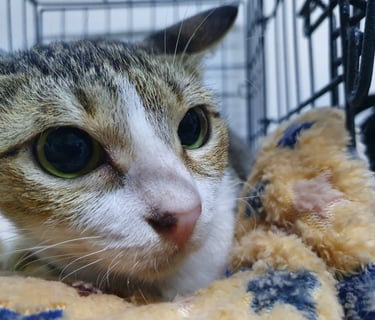

A terrified Ninja waiting for surgery prep,
October 2021


